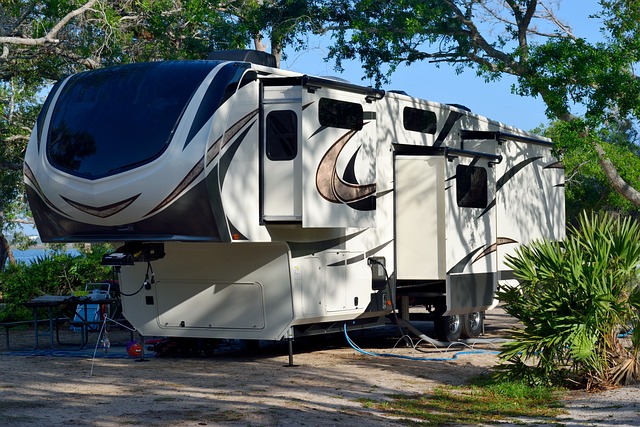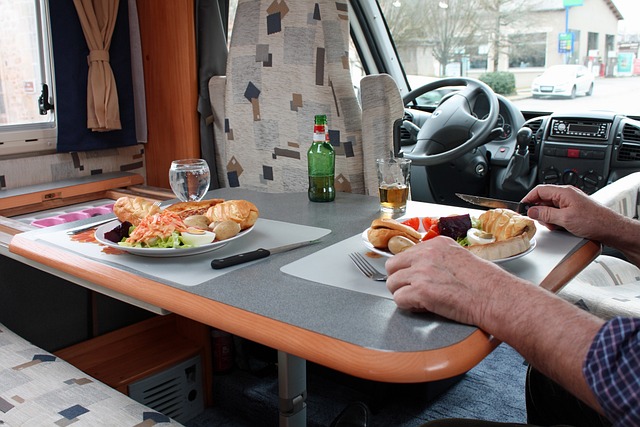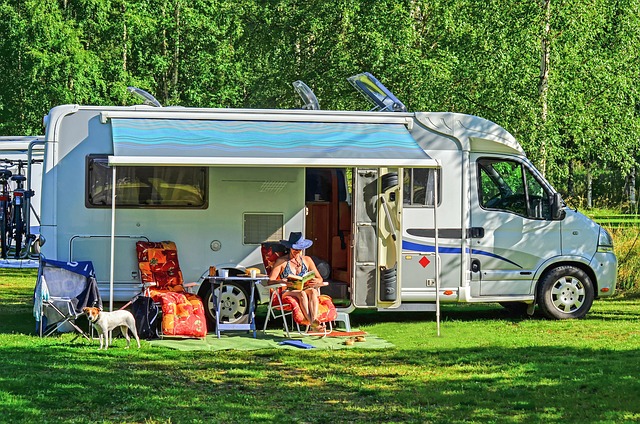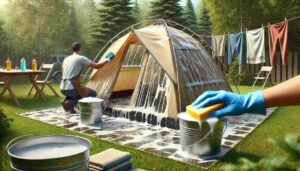Living full-time in a stationary RV has become an increasingly popular lifestyle choice for those seeking freedom, adventure, and a simpler way of living. Whether you’re a retiree looking to downsize or a digital nomad craving flexibility, embracing stationary RV living offers a unique opportunity to experience life on the road while enjoying the comforts of a home. As an expert in the field, I understand the ins and outs of this lifestyle and the considerations necessary to make it a successful and fulfilling experience. In this comprehensive guide, I will provide you with valuable insights, practical tips, and expert advice to help you prepare for the exciting journey of full-time stationary RV living.
By the end of this article, you will be equipped with the knowledge and confidence to select the right RV, find the perfect location, navigate financial planning, downsize and organize your belongings, handle practical considerations, set up utilities and services, create a comfortable living space, establish routines and lifestyle, manage maintenance and repairs, and stay connected and engaged with the world around you.
Whether you’re an aspiring full-time RVer or already on the verge of embarking on this adventure, this article will serve as your trusted companion, providing you with the guidance you need to make the most of your stationary RV lifestyle. So let’s dive in and discover how to prepare for the remarkable experience of full-time stationary RV living.
Selecting the Right RV
Choosing the right RV is a crucial step in preparing for full-time stationary RV living. The type, size, layout, and features of your RV will significantly impact your comfort, convenience, and overall experience. Here are some essential considerations to help you make an informed decision:
Types of RVs:
- Motorhomes: Motorhomes are self-contained units with a built-in engine. They are available in three classes: a. Class A: Large, luxurious motorhomes resembling buses, offering spacious interiors and plenty of amenities. b. Class B: Compact camper vans that are easy to drive and maneuver, suitable for individuals or couples. c. Class C: Mid-sized motorhomes with a distinctive cab-over design, providing additional sleeping or storage space.
- Travel Trailers: These are towable RVs that require a separate vehicle for towing. They come in various sizes and configurations, offering versatility and ease of use.
- Fifth Wheels: Fifth wheels are towable RVs that attach to a special hitch mounted in the bed of a pickup truck. They are known for their spaciousness and residential-style features.
- Park Models: Park models are larger, stationary RVs designed to resemble small homes. They are not meant to be moved frequently and are ideal for long-term stays in RV parks or communities.
Size and Layout:
- Consider the number of occupants and their individual needs. Determine the required number of beds, bathrooms, and living spaces to accommodate everyone comfortably.
- Assess storage space requirements, including closets, cabinets, and exterior compartments, to ensure you have enough room for your belongings.
- Evaluate the layout to ensure it suits your preferences and lifestyle. Look for features such as a functional kitchen, ample seating, and a designated workspace if needed.
Features and Amenities:
- Insulation: Opt for RVs with excellent insulation to maintain comfortable temperatures year-round and reduce energy consumption.
- Climate Control: Look for heating and cooling systems that are efficient and adjustable for different weather conditions.
- Appliances: Consider the type and quality of appliances provided, including a refrigerator, stove, microwave, and washer/dryer if desired.
- Water and Power Systems: Ensure the RV has adequate fresh water storage capacity and a reliable power system, such as a generator or solar panels, to meet your needs.
- Connectivity: If you require internet access, consider RVs equipped with Wi-Fi or built-in connectivity options.
Remember to thoroughly research and visit RV dealerships or attend RV shows to view different models in person. Take the time to inspect the construction quality, test the functionality of features, and envision yourself living comfortably in the RV of your choice.

Finding the Perfect Location
Selecting the right location for your full-time stationary RV living is crucial to ensure a comfortable and enjoyable experience. Here are some key considerations to help you find the perfect spot:
Research Potential RV Parks or Campgrounds:
- Look for RV parks or campgrounds that cater to long-term or full-time residents. These places often provide amenities and services suitable for extended stays.
- Consider the location of the RV park in relation to your desired area or proximity to attractions, amenities, healthcare facilities, and essential services.
- Read reviews and ratings from other RVers to get insights into the quality of the park, the friendliness of the staff, and the overall experience of living there.
Factors to Consider:
- Climate: Evaluate the climate of the location you’re considering. Ensure it aligns with your preferences and that you are prepared for any extreme weather conditions.
- Access to Amenities: Check if the RV park or nearby area offers amenities such as grocery stores, pharmacies, restaurants, recreational facilities, and entertainment options.
- Proximity to Nature: If you enjoy outdoor activities, consider locations that provide access to natural attractions like national parks, hiking trails, lakes, or beaches.
- Community and Social Opportunities: Look for RV parks that foster a sense of community and offer social events or activities to connect with fellow RVers.
Resources for Finding Suitable RV Communities or Parks:
- Online Directories: Utilize online directories specifically tailored for RV parks and campgrounds, such as RV Park Reviews, Campendium, or Good Sam Club.
- RV Forums and Communities: Engage with online RV forums and communities to seek recommendations and advice from experienced full-time RVers.
- Word-of-Mouth Recommendations: Reach out to fellow RVers or friends who have experience with full-time stationary RV living for personal recommendations.
Once you have shortlisted potential locations, consider visiting them in person or making virtual tours to get a better sense of the surroundings, facilities, and overall atmosphere. Additionally, contact the RV park or campground management to inquire about availability, rates, and any specific requirements they may have for full-time residents.
Finding the perfect location for your full-time stationary RV living involves careful research and consideration.

Financial Planning
Proper financial planning is essential when preparing for full-time stationary RV living. Understanding the costs involved and budgeting effectively will help ensure a sustainable and enjoyable lifestyle. Consider the following aspects when creating your financial plan:
Cost Implications:
- RV Purchase or Rental: Determine whether you plan to purchase or rent an RV. Research prices and financing options if buying, or compare rental rates if opting for a temporary arrangement.
- Monthly Rent or Site Fees: Calculate the monthly costs of staying in an RV park or campground. Consider any additional charges for amenities, utilities, or premium sites.
- Utilities: Estimate expenses for electricity, water, propane, and any other utilities required for your RV.
- Insurance: Protect your RV investment with comprehensive insurance coverage. Research insurance providers specializing in RV coverage and compare quotes.
- Maintenance and Repairs: Budget for routine maintenance tasks, such as oil changes and inspections, as well as unexpected repairs that may arise.
Budgeting Process:
- Evaluate Income and Expenses: Assess your sources of income, including retirement savings, investments, or remote work opportunities. Determine your monthly expenses, including food, healthcare, entertainment, and other personal needs.
- Create a Realistic Budget: Allocate funds for necessary expenses, such as rent, utilities, insurance, and maintenance, while also accounting for discretionary spending and savings.
- Track and Adjust: Regularly monitor your budget and make adjustments as needed to ensure you stay within your financial means.
Saving Money and Managing Finances:
- Embrace Minimalism: Downsizing your possessions and adopting a minimalist lifestyle can reduce expenses and free up space in your RV.
- Discount Programs and Memberships: Explore RV membership clubs and discount programs like Good Sam Club or Passport America, which offer savings on RV parks, campgrounds, and other services.
- Workamping or Volunteering: Consider workamping opportunities where you can exchange work for reduced or free site fees. Volunteering at national parks or campgrounds can also provide benefits such as free or discounted stays.
It’s crucial to be realistic about your financial capabilities and adjust your lifestyle and spending accordingly. Regularly review your financial plan to ensure it aligns with your goals and adjust as necessary.

Downsizing and Organizing
Downsizing and organizing your belongings is a vital step in preparing for full-time stationary RV living. As space in an RV is limited, it’s essential to minimize clutter and maximize storage efficiency. Here’s how to effectively downsize and organize for RV living:
Decluttering:
- Assess Your Belongings: Evaluate each item you own and determine its necessity and practicality for RV living. Be honest with yourself and consider donating, selling, or discarding items you no longer need or use.
- Categorize and Prioritize: Sort your belongings into categories such as clothing, kitchenware, electronics, and sentimental items. Prioritize essential items and consider multi-purpose items that can serve multiple functions.
- Sentimental Items: Store sentimental items in a designated storage unit or with a trusted family member or friend. Take photos of sentimental items for memory purposes.
Storage Solutions:
- Maximize Cabinet Space: Utilize stackable or collapsible storage containers and organizers to optimize cabinet space. Consider adjustable shelves or drawer dividers to customize storage compartments.
- Use Vertical Space: Install hooks, racks, or hanging storage solutions on walls and doors to hang coats, hats, towels, or other items. Utilize hanging shoe organizers for storing small items.
- Under-Bed Storage: Utilize under-bed storage containers or vacuum-sealed bags to store seasonal clothing, bedding, or other items that are not frequently needed.
- Outdoor Storage: Utilize exterior compartments, such as storage bays or rooftop cargo carriers, for larger outdoor gear or equipment.
Minimalist Lifestyle:
- Embrace Multi-purpose Items: Opt for items that serve multiple functions, such as a collapsible colander, nesting cookware, or a sofa that converts into a bed.
- Digitize Documents: Scan important documents and store them digitally to reduce paper clutter. Utilize cloud storage or external hard drives for secure digital storage.
- Rent or Borrow: Consider renting or borrowing items that are used infrequently, such as specialized tools or recreational equipment, to save space and money.
Remember, downsizing is an ongoing process. As you adjust to your new lifestyle, reevaluate your belongings periodically and let go of items that no longer serve a purpose or bring you joy.
Practical Considerations
When preparing for full-time stationary RV living, it’s crucial to address various practical considerations to ensure a smooth and hassle-free experience. Here are some important factors to keep in mind:
Legal and Regulatory Requirements:
- RV Licenses and Registrations: Familiarize yourself with the legal requirements regarding RV licenses, registrations, and vehicle inspections in your jurisdiction. Ensure your RV meets all necessary regulations.
- Permits and Zoning: Research the permits and zoning regulations specific to the area where you plan to park your RV. Some jurisdictions have restrictions on long-term RV occupancy, while others may require specific permits for extended stays.
- Residency Requirements: Understand the residency requirements of the state or country you plan to establish as your domicile. This includes considerations such as driver’s license, vehicle registration, and voting registration.
Health and Safety Considerations:
- Health Insurance: Ensure you have appropriate health insurance coverage that extends to your full-time RV lifestyle. Consider policies that provide coverage in various locations and offer emergency medical assistance.
- Vehicle Insurance: Secure comprehensive RV insurance coverage to protect your vehicle against accidents, theft, and damage. Verify that your policy covers both stationary and mobile RV use.
- Emergency Preparedness: Equip your RV with essential safety equipment such as smoke detectors, carbon monoxide detectors, fire extinguishers, and a first aid kit. Develop an emergency plan and familiarize yourself with emergency services in the areas you plan to stay.
Insurance and Extended Warranty:
- RV Insurance: Research insurance providers specializing in RV coverage and compare policies to ensure you have comprehensive coverage tailored to your specific needs.
- Extended Warranty: Consider purchasing an extended warranty for your RV to protect against unexpected mechanical failures or repairs. Review warranty terms, coverage limitations, and deductibles before making a decision.
Community and Social Engagement:
- Join RV Clubs and Communities: Engage with RV clubs and online communities to connect with fellow RVers and access valuable resources, tips, and support.
- Attend RV Events and Gatherings: Participate in RV events, rallies, and gatherings to meet like-minded individuals and build a sense of community.
Mail and Legal Address:
- Mail Forwarding Service: Utilize a mail forwarding service to handle your mail and receive it at a designated address while you’re on the move. These services can forward mail to you wherever you’re located.
- Legal Address: Establish a legal address for official purposes, such as receiving important documents or filing taxes. Consider using a mail forwarding service or a trusted family member’s address.
It’s essential to stay informed about the legal, regulatory, and safety aspects of full-time stationary RV living.
Setting Up Utilities and Services
Setting up utilities and services is an important step in preparing for full-time stationary RV living. Ensuring access to essential amenities will contribute to your comfort and convenience. Here are some considerations for setting up utilities and services in your RV:
Water:
- Fresh Water Supply: Determine the availability of a freshwater hookup at your chosen RV park or campground. If not available, plan for alternative water sources such as carrying portable water containers or utilizing on-site water fill stations.
- Water Filtration: Install a water filtration system or use a portable water filter to ensure the quality and safety of your water supply.
Electricity:
- Power Hookup: Verify whether your chosen RV park or campground offers electrical hookups. Understand the electrical capacity (amp service) available and ensure it meets your RV’s requirements.
- Electrical Adapters: Carry electrical adapters to accommodate different types of electrical outlets commonly found in RV parks or campgrounds.
Sewage and Waste Disposal:
- Sewage Hookup: Check if your RV park or campground provides sewage hookups. If available, connect your RV’s waste system directly to the sewage system.
- Dump Stations: Identify nearby dump stations for waste disposal if a sewage hookup is not available. Learn proper waste disposal procedures and adhere to campground or park regulations.
Internet and Communication:
- Wi-Fi: Evaluate the availability and quality of Wi-Fi at your chosen RV park or campground. If reliable internet access is essential, consider RV parks known for their good connectivity or explore mobile hotspot options.
- Cellular Coverage: Research the strength of cellular coverage in the area. Consider boosting signals with signal boosters or antennas to improve reception.
- Mail and Package Delivery: Coordinate mail and package delivery through a mail forwarding service or use the address of your chosen RV park or campground.
Waste Management and Recycling:
- Trash Disposal: Familiarize yourself with the garbage disposal system at your RV park or campground. Follow the guidelines for separating recyclables and disposing of waste properly.
- Recycling: Find out if the RV park or campground has recycling facilities available. Sort and recycle your recyclable waste accordingly.
It’s essential to communicate with the management of your chosen RV park or campground to understand their specific policies, services, and any associated costs related to utilities.
Creating a Comfortable Living Space
Designing and organizing your RV interior will significantly impact your comfort and enjoyment during full-time stationary RV living. With limited space available, it’s essential to maximize functionality and create a cozy atmosphere. Consider the following tips to create a comfortable living space inside your RV:
Furniture and Layout:
- Multi-functional Furniture: Choose furniture pieces that serve multiple purposes, such as a sofa bed, convertible dining table, or storage ottomans.
- Space-Saving Solutions: Opt for furniture with built-in storage compartments or choose collapsible furniture that can be easily stowed away when not in use.
- Traffic Flow: Arrange furniture in a way that allows for smooth movement and accessibility within the RV.
Storage Solutions:
- Utilize Vertical Space: Install wall-mounted shelves or hanging organizers to store books, decor, or kitchen items.
- Under-Bed Storage: Utilize storage containers or vacuum-sealed bags to store clothing, bedding, or other items beneath the bed.
- Overhead Cabinets: Maximize overhead cabinet space by using stackable containers or adding additional shelves or dividers.
Lighting and Ambiance:
- Natural Light: Keep curtains or blinds open during the day to maximize natural light and create a more spacious feel.
- LED Lighting: Replace traditional bulbs with energy-efficient LED lights to enhance illumination and reduce energy consumption.
- Accent Lighting: Add LED strip lights or battery-operated candles to create a cozy and relaxing ambiance.
Decor and Personalization:
- Colors and Textures: Choose light and neutral colors to create an open and airy feel. Add pops of color and textures through cushions, curtains, or rugs.
- Wall Decor: Hang artwork, mirrors, or removable decals to personalize the space and make it feel more like home.
- Indoor Plants: Incorporate small potted plants or succulents to bring life and freshness into your RV.
Climate Control:
- Insulation: Ensure your RV is well-insulated to maintain comfortable temperatures year-round. Consider adding window coverings or thermal curtains to regulate heat or cold.
- Ventilation: Install vent fans or portable fans to improve air circulation and regulate temperature.
- Weather-appropriate Bedding: Use bedding suitable for different seasons, such as lightweight sheets and blankets for summer and thicker comforters for winter.
Remember to keep your RV organized and free from clutter to create an inviting and comfortable living space. Regularly assess your belongings and make adjustments as needed to maintain an organized and functional RV interior.
Establishing Routines and Lifestyle
Establishing routines and maintaining a balanced lifestyle is key to making the most of your full-time stationary RV living experience. By incorporating structure and embracing a healthy work-life balance, you can enhance your overall well-being and enjoyment. Consider the following suggestions for establishing routines and a fulfilling lifestyle:
Daily Routine:
- Set a Regular Wake-Up Time: Establish a consistent wake-up time to start your day with a sense of routine.
- Morning Rituals: Incorporate activities like exercise, meditation, or journaling into your mornings to kickstart your day positively.
- Meal Planning: Plan and prepare meals in advance to save time and ensure a healthy diet. Utilize local produce and explore new recipes to add variety to your meals.
- Dedicated Work Hours: If you work remotely, establish dedicated work hours and create a designated workspace within your RV.
Leisure and Recreation:
- Outdoor Activities: Take advantage of the natural surroundings and engage in outdoor activities like hiking, biking, fishing, or birdwatching.
- Explore Local Attractions: Discover the unique attractions and landmarks in the areas you visit. Visit museums, art galleries, historical sites, or attend local events or festivals.
- Socializing: Engage with fellow RVers and participate in social activities organized within the RV park or campground. Attend potlucks, game nights, or group outings to connect with the community.
Self-Care and Relaxation:
- Unplug and Recharge: Dedicate time to unplug from technology and enjoy moments of relaxation and solitude. Engage in activities like reading, taking walks, or practicing mindfulness.
- Stay Active: Incorporate regular exercise into your routine. Engage in activities such as yoga, hiking, or cycling to stay fit and energized.
- Hobbies and Interests: Pursue your hobbies and interests within the limited space available. Whether it’s painting, playing a musical instrument, or crafting, find ways to indulge in activities that bring you joy.
Engaging with the Community:
- Attend Park/Campground Events: Participate in organized activities or events within the RV park or campground to meet fellow residents and build connections.
- Volunteer Opportunities: Explore volunteer opportunities in the local community or nearby nature conservation areas. Contributing your time and skills can provide a sense of fulfillment and create lasting relationships.
Work-Life Balance:
- Establish Boundaries: Clearly define boundaries between work and personal life to maintain a healthy balance. Set specific work hours and avoid letting work spill over into leisure time.
- Take Breaks and Rest Days: Allow yourself regular breaks and rest days to recharge and avoid burnout. Disconnect from work-related tasks during these times.
Remember, the beauty of full-time stationary RV living lies in the flexibility it offers. Adapt your routines and lifestyle to suit your preferences and make adjustments as needed to ensure a fulfilling and balanced experience.
Maintenance and Repairs
Proper maintenance and prompt repairs are essential to keep your RV in excellent condition and ensure a smooth and enjoyable full-time stationary RV living experience. Regular upkeep and addressing issues promptly can prevent costly repairs and extend the lifespan of your RV. Consider the following guidelines for maintaining and repairing your RV:
Routine Maintenance Tasks:
- Regular Inspections: Conduct routine inspections of your RV’s exterior, interior, and mechanical components. Look for signs of wear and tear, leaks, or damage.
- Fluid Checks and Changes: Regularly check and change engine oil, coolant, transmission fluid, brake fluid, and other vital fluids as recommended by the manufacturer.
- Tire Maintenance: Inspect tires for wear, check tire pressure regularly, and rotate them as per the manufacturer’s guidelines. Replace tires when necessary.
- Battery Care: Maintain and test your RV’s batteries regularly. Clean terminals, check water levels (if applicable), and replace batteries when needed.
Systems and Appliances:
- HVAC Systems: Clean or replace air filters regularly to ensure efficient operation. Schedule professional maintenance for HVAC systems as needed.
- Plumbing and Water Systems: Inspect plumbing connections, fixtures, and water lines for leaks. Clean or replace water filters regularly and address any issues promptly.
- Propane Systems: Regularly inspect and test propane systems for leaks or malfunctions. Ensure propane tanks are properly secured and comply with safety regulations.
- Electrical Systems: Check electrical connections, outlets, and circuit breakers regularly. Replace any faulty components and ensure compliance with safety standards.
Troubleshooting Common Issues:
- Electrical Problems: Familiarize yourself with the RV’s electrical system and troubleshoot basic issues such as blown fuses, tripped circuit breakers, or faulty connections.
- Plumbing Leaks: Address plumbing leaks promptly by tightening connections or replacing worn-out components. Use sealants or plumber’s tape to prevent future leaks.
- HVAC Issues: If you encounter HVAC problems, check thermostat settings, clean or replace air filters, and inspect for obstructions in air ducts or vents.
Professional Services:
- Regular Servicing: Schedule regular professional servicing of your RV, including engine maintenance, generator service, and overall inspections. This can help identify potential issues early on.
- Authorized Repair Centers: Locate authorized repair centers or technicians specializing in RV repairs. Research their reputation and expertise before entrusting them with your RV.
DIY Repairs:
- Basic Toolkit: Equip yourself with a basic toolkit that includes essential tools for common RV repairs and maintenance tasks.
- DIY Resources: Utilize online resources, forums, and instructional videos to learn how to troubleshoot and perform basic repairs on your RV. Exercise caution and seek professional help for complex repairs or if you’re unsure.
Regular maintenance, prompt repairs, and a proactive approach to addressing issues will help keep your RV in optimal condition, ensuring a worry-free and enjoyable full-time stationary RV living experience.
Staying Connected and Engaged
Living in a stationary RV doesn’t mean you have to disconnect from the world. Staying connected and engaged is vital for maintaining social connections, accessing information, and making the most of your full-time stationary RV living. Consider the following suggestions to stay connected and engaged:
Communication and Connectivity:
- Mobile Internet: Ensure reliable internet connectivity by investing in a mobile hotspot or utilizing data plans with a strong network coverage. Research providers and plans suitable for your needs.
- Wi-Fi Availability: Seek RV parks or campgrounds that offer reliable Wi-Fi services. Check the quality and coverage area of their Wi-Fi network.
- Satellite Internet: If you frequently stay in remote areas without reliable internet coverage, consider satellite internet options for consistent connectivity.
Social Media and Online Communities:
- RVing Forums and Groups: Join online RVing forums, social media groups, and communities to connect with fellow RVers, ask questions, and share experiences. These platforms offer a wealth of knowledge and support.
- Blogging or Vlogging: Consider starting your own blog or YouTube channel to document your full-time stationary RV living journey. Share your experiences, tips, and insights to connect with others in the RV community.
Local Community Engagement:
- Volunteer Opportunities: Engage in volunteer activities within the local community. Contribute your skills and time to causes or organizations that align with your interests.
- Attend Local Events: Stay informed about local events, festivals, farmers’ markets, or community gatherings happening in the areas you reside. Participate in these events to immerse yourself in the local culture.
Explore Surrounding Areas:
- Day Trips and Excursions: Take advantage of your RV’s mobility to explore nearby attractions, landmarks, hiking trails, or scenic drives. Research and plan day trips to discover new places.
- Outdoor Activities: Engage in outdoor activities available in the vicinity, such as kayaking, fishing, cycling, or nature walks. Embrace the natural beauty surrounding your RV location.
Stay Connected with Friends and Family:
- Video Calls and Messaging: Utilize video calling platforms and messaging apps to stay in touch with friends and family. Schedule regular video calls to maintain close connections.
- Plan Visits: Coordinate visits from loved ones, inviting them to experience your stationary RV lifestyle. Make plans to explore local attractions together.
Remember, staying connected and engaged requires proactive efforts. Embrace technology, engage in local communities, and explore the surrounding areas to make the most of your full-time stationary RV living experience.
Conclusion
Congratulations on completing this comprehensive guide on how to prepare for full-time stationary RV living. Throughout this article, I have covered essential aspects of this lifestyle, from selecting the right RV to establishing routines and staying connected. By following the expert advice provided, you can embark on a fulfilling and rewarding journey in your stationary RV home.
Remember, selecting the right RV that suits your needs and preferences is crucial. Conduct thorough research and consider factors such as size, layout, features, and durability. Finding the perfect location involves evaluating factors like climate, amenities, and community opportunities.
Financial planning is vital for a sustainable lifestyle. Calculate costs, create a budget, and explore money-saving strategies. Downsizing and organizing your belongings will help maximize space and minimize clutter. Focus on functionality and utilize storage solutions effectively.
Address practical considerations such as legal requirements, health and safety considerations, and insurance coverage. Set up utilities and services like water, electricity, sewage, and internet connectivity to ensure comfort and convenience.
Create a comfortable living space by optimizing furniture, utilizing storage solutions, and adding personal touches. Establish routines, engage in leisure activities, prioritize self-care, and connect with the RV community to maintain a balanced and fulfilling lifestyle.
Stay proactive with maintenance and repairs to keep your RV in excellent condition. Regular inspections, addressing issues promptly, and seeking professional help when needed will prolong the lifespan of your RV.
Stay connected and engaged by utilizing communication and connectivity options, joining online communities, engaging with local communities, exploring surrounding areas, and maintaining connections with friends and family.
Embrace the remarkable journey of full-time stationary RV living with confidence and excitement. Remember to adapt and personalize your experience according to your preferences and enjoy the freedom, adventure, and simplicity that this lifestyle offers.
Do you have any further questions or require assistance, don’t hesitate to seek guidance from experts or reach out to the RV community. Wishing you an incredible and fulfilling full-time stationary RV living experience!
You might also like: Camper Van Vs RV









